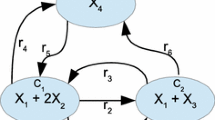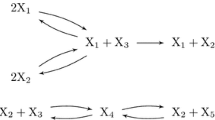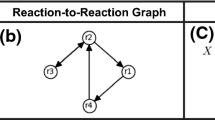Abstract
In this paper we show that the model form of a wide class of kinetic systems with rational terms in the reaction rates is invariant under a positive linear diagonal transformation. Thus, the concept of linear conjugacy defined originally for mass action systems is extended to rational biochemical models. The generalized Kirchhoff matrix and the kinetic weighting matrix of the linearly conjugate models are given as functions of the computed transformation parameters. It is shown through the illustrative examples that the dense realization of a linearly conjugate rational model may contain more reactions than that of a dynamically equivalent one due to the additional degrees of freedom introduced by the linear transformation. The proposed matrix-based representation is suitable for the computational search of preferred graph structures corresponding to linearly conjugate realizations of rational kinetic models.


Similar content being viewed by others
References
B. Ács, G. Szederkényi, Z. Tuza, Z.A. Tuza, Computing linearly conjugate weakly reversible kinetic structures using optimization and graph theory. MATCH Commun. Math. Comput. Chem. 74(3), 481–504 (2015)
D.F. Anderson, A proof of the global attractor conjecture in the single linkage class case. SIAM J. Appl. Math. 71, 1487–1508 (2011)
D. Angeli, P. De Leenher, E.D. Sontag, A Petri net approach to the study of persistence in chemical reaction networks. Math. Biosci. 210, 598–618 (2007)
M. Banaji, C. Pantea, Some results on injectivity and multistationarity in chemical reaction networks. arXiv:1309.6771 [math.DS] (2015)
V. Chellaboina, Modeling and analysis of mass-action kinetics. IEEE Control Syst. Mag. 29, 60–78 (2009)
G. Craciun, Toric differential inclusions and a proof of the global attractor conjecture. arXiv:1501.02860v2 [math.DS] (2016)
G. Craciun, C. Pantea, Identifiability of chemical reaction networks. J. Math. Chem. 44, 244–259 (2008)
G. Craciun, M. Feinberg, Multiple equilibria in complex chemical reaction networks: I. The injectivity property. SIAM J. Appl. Math. 65(5), 1526–1546 (2005)
A. Császár, L. Jicsinszky, T. Turányi, Generation of model reactions leading to limit cycle behaviour. React. Kinet. Catal. Lett 18(1–2), 65–71 (1981)
P. Donnell, M. Banaji, Local and global stability of equilibria for a class of chemical reaction networks. SIAM J. Appl. Dyn. Syst. 12, 899–920 (2013)
P. Érdi, J. Tóth, Mathematical Models of Chemical Reactions. Theory and Applications of Deterministic and Stochastic Models (Manchester University Press, Princeton University Press, Manchester, Princeton, 1989)
G. Farkas, Kinetic lumping schemes. Chem. Eng. Sci. 54, 3909–3915 (1999)
M. Feinberg, Chemical reaction network structure and the stability of complex isothermal reactors—I. The deficiency zero and deficiency one theorems. Chem. Eng. Sci. 42(10), 2229–2268 (1987)
M. Feinberg, Necessary and sufficient conditions for detailed balancing mass action systems of arbitrary complexity. Chem. Eng. Sci. 44(9), 1819–1827 (1989)
A. Gábor, K.M. Hangos, J.R. Banga, G. Szederkényi, Reaction network realizations of rational biochemical systems and their structural properties. J. Math. Chem. 53, 1657–1686 (2015)
V. Hárs, J. Tóth, On the inverse problem of reaction kinetics, in Coll. Math. Soc. J. Bolyai, vol. 30, ed. by M. Farkas, L. Hatvani (North-Holland, Amsterdam, 1981), pp. 363–379
B. Hernandez-Bermejo, V. Fairen, L. Brenig, Algebraic recasting of nonlinear ODEs into universal formats. J. Phys. A Math. Gen. 31, 2415–2430 (1998)
F. Horn, R. Jackson, General mass action kinetics. Arch. Ration. Mech. Anal. 47(2), 81–116 (1972)
M.D. Johnston, D. Siegel, G. Szederkényi, A linear programming approach to weak reversibility and linear conjugacy of chemical reaction networks. J. Math. Chem. 50, 274–288 (2012)
M.D. Johnston, D. Siegel, Linear conjugacy of chemical reaction networks. J. Math. Chem. 49(7(7)), 1263–1282 (2011)
M.D. Johnston, D. Siegel, G. Szederkényi, Dynamical equivalence and linear conjugacy of chemical reaction networks: new results and methods. MATCH Commun. Math. Comput. Chem. 68, 443–468 (2012)
M.D. Johnston, D. Siegel, G. Szederkényi, Computing weakly reversible linearly conjugate chemical reaction networks with minimal deficiency. Math. Biosci. 241(1(1)), 88–98 (2013)
G. Lipták, G. Szederkényi, K.M. Hangos, Computing zero deficiency realizations of kinetic systems. Syst. Control Lett. 81, 24–30 (2015)
J. Löfberg. YALMIP : A Toolbox for Modeling and Optimization in MATLAB. in Proceedings of the CACSD Conference, Taipei, Taiwan (2004)
M. Mincheva, D. Siegel, Stability of mass action reaction–diffusion systems. Nonlinear Anal. Theory Methods Appl. 56(8), 1105–1131 (2004)
M. Mincheva, M.R. Roussel, Graph-theoretic methods for the analysis of chemical and biochemical networks. I. Multistability and oscillations in ordinary differential equation models. J. Math. Biol. 55(1), 61–86 (2007)
S. Müller, G. Regensburger, Generalized mass action systems: complex balancing equilibria and sign vectors of the stoichiometric and kinetic-order subspaces. SIAM J. Appl. Math. 72, 1926–1947 (2012)
J. Rudan, G. Szederkényi, K.M. Hangos, Efficient computation of alternative structures for large kinetic systems using linear programming. MATCH Commun. Math. Comput. Chem. 71, 71–92 (2014)
N. Samardzija, L.D. Greller, E. Wassermann, Nonlinear chemical kinetic schemes derived from mechanical and electrical dynamical systems. J. Chem. Phys. 90(4), 2296–2304 (1989)
G. Shinar, M. Feinberg, Structural sources of robustness in biochemical reaction networks. Science 327(5971), 1389–1391 (2010)
G. Szederkényi, Computing sparse and dense realizations of reaction kinetic systems. J. Math. Chem. 47(2), 551–568 (2010)
G. Szederkényi, K.M. Hangos, Z.S. Tuza, Finding weakly reversible realizations of chemical reaction networks using optimization. MATCH Commun. Math. Comput. Chem. 67, 193–212 (2012)
L. Szili, J. Tóth, On the origin of Turing instability. J. Math. Chem. 22(1), 39–53 (1997)
A.I. Vol’pert, Differential equations on graphs. Math. USSR-Sbornik 17(4), 571–582 (1972)
Acknowledgments
AG is supported by the funding from EU FP7 ITN “NICHE”, Project No. 289384. KMH acknowledges the funding from the National Research, Development and Innovation Office—NKFIH through Grant No. 115694. GSz acknowledges the support of the National Research, Development and Innovation Office—NKFIH through Grant No. NF104706. The authors thank Bernadett Ács for carefully reading the manuscript.
Author information
Authors and Affiliations
Corresponding author
Rights and permissions
About this article
Cite this article
Gábor, A., Hangos, K.M. & Szederkényi, G. Linear conjugacy in biochemical reaction networks with rational reaction rates. J Math Chem 54, 1658–1676 (2016). https://doi.org/10.1007/s10910-016-0642-7
Received:
Accepted:
Published:
Issue Date:
DOI: https://doi.org/10.1007/s10910-016-0642-7




